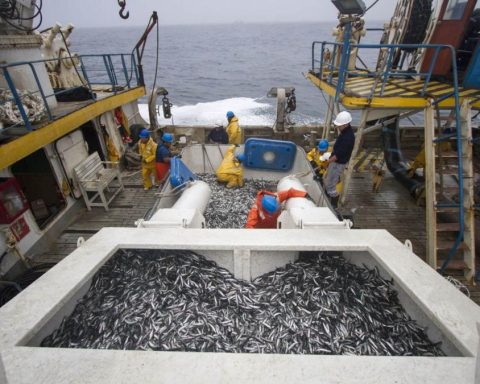The Peruvian economy slowed down in November, with a growth of the gross domestic product (GDP) of 1.68% compared to the same month of 2021, reported the National Institute of Statistics and Informatics (INEI). This result was lower than that of October 2022.
In addition, in the period from January to November last year, production increased 2.7%.
Regarding the production of November, the INEI reported that four sectors presented falls. What factors influenced the slowdown in the ninth month of the year?
fish production
The Fishing sector decreased 48.52% as a result of the lower extraction of species of maritime origin (-50.27%), mainly for indirect human consumption (anchovy for fishmeal and fish oil), registering an extraction of 310,539 tons that, compared to the 917,919 tons in November 2021, presented a reduction of 66.17%; This catch corresponded to the Second Anchovy Fishing Season in the North-Central Zone of the Peruvian coast, which began on November 28, 2022.
A similar unfavorable trend was presented by fishing for direct human consumption (-15.63%), observing a decrease in fishing for the preparation of cured (-54.0%), frozen (-18.7%), canned (-18.3%) and for consumption. in fresh state (-9.2%). On the other hand, fishing of continental origin decreased 24.81%, due to less extraction of species for consumption in fresh state (-44.95%).
manufacturing in red
In the month of study, production in the Manufacturing sector fell by 2.83% as a result of lower activity in both the non-primary subsector (-2.48%) and the primary subsector (-3.88%). The unfavorable result of the non-primary subsector was determined by the low production of intermediate goods (-6.41%) and capital goods (-2.50%); while the consumer goods industry increased (1.12%).
The negative behavior of the primary subsector is explained by the lower dynamism in the branches of fish processing and preservation (-47.2%), manufacturing of petroleum refining products (-18.4%) and sugar processing (-7.6%); however, production grew in the branches of manufacturing primary products of precious metals (73.9%), as well as meat processing and preservation (1.4%).
Telecommunications and other information services
In November 2022, the telecommunications and other information services sector decreased by 5.71% due to the negative performance of the telecommunications subsector (-7.08%); while the other information services subsector grew (5.20%).
In the telecommunications subsector, data transmission services (-20.7%) and telephony (-10.1%), both fixed and mobile, decreased; however, Internet service and subscription television grew (0.3%). The growth of the other information services subsector was influenced by the greater production and exhibition of programs and films (16.8%), computer programming (10.6%) and TV and radio programming (3.1%); however, the edition decreased (-4.8%).
Financial Sector and Insurance
The Financial and Insurance sector contracted 9.62% as a result of lower credits (-4.95%) and deposits (-8.11%) from commercial banks. According to segment, loans directed to corporate, large, medium, small and micro-enterprises decreased (-10.5%); as well as mortgage loans for housing (-0.42%); situation that was mitigated by the increase in consumer loans (14.5%). According to economic sectors, the credits destined to the commercial sector were reduced; real estate, business and rental activities; manufacture; transport, storage and communications; electricity, gas and water, and construction.
The reduction of multiple banking deposits was observed in the categories of Compensation for Service Time (-23.3%), Demand Deposits (-17.1%) and Savings Deposits (-14.9%); however, Time Deposits grew (20.7%).
construction and mining
Despite the negative results of the aforementioned sectors in November, the other activities reported positive results, highlighting some such as mining and construction.
The production of the Construction sector rose by 6.83% due to the greater physical progress of works in 39.78%; however, internal cement consumption was reduced by 2.10%. The physical progress of works stood out at the level: Local (62.1%) and Regional (56.9%); however, it decreased at the National level (-4.5%). Thus, the works of reconstruction, rehabilitation and improvements of highways and neighborhood roads stood out; sanitation works; improvements to irrigation canals, expansion of flood protection works on river banks, among others.
While the decrease in internal cement consumption was explained by the lower dynamism in private works and self-construction, it is the case of office remodeling and expansion projects, the habilitation of land for urban centers; works in industrial plants, complementary infrastructure for electrical services, among the main ones.
The Mining and Hydrocarbons sector increased by 5.06% driven by the good performance of the metal mining activity at 5.90%, associated with higher volumes of copper (14.6%), tin (9.1%), iron (6.2%) and zinc (1.2%); however, the production of molybdenum (-15.0%), silver (-10.2%), lead (-6.8%) and gold (-2.9%) was affected.
Also, the hydrocarbons subsector increased by 0.15% supported by the greater exploitation of natural gas (11.5%); offset by lower extraction of natural gas liquids (-7.2%) and crude oil (-0.1%).
Another case was the Electricity, Gas and Water sector, which increased by 5.65%, sustained by the higher production of the electricity (6.45%), water (0.91%) and gas distribution (0.52%) subsectors. The growth of the electricity subsector was influenced by the greater generation of energy from thermoelectric origin (48.3%); however, the generation of hydroelectric energy (-25.5%) and non-conventional renewable energy (-9.69%) decreased.
The progress of the water subsector was based on the highest reported level of drinking water production of the companies: Seda Chimbote (2.8%), Sedapar (2.6%), Epsel (1.4%) and Sedapal (0.1%), among the main ones; the progress reported in the gas subsector was explained by the increase in distribution to companies (5.8%) and to establishments that sell Vehicular Natural Gas-GNV (19.3%); however, the distribution to Electric Generators decreased (-0.4%).















